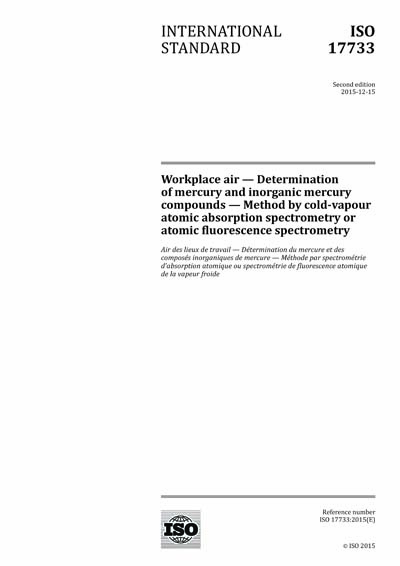Most recent
ISO 17733:2015
Workplace air - Determination of mercury and inorganic mercury compounds - Method by cold-vapour atomic absorption spectrometry or atomic fluorescence spectrometry
ISO 17733:2015 specifies a procedure for determination of the time-weighted average mass concentration of mercury vapour and inorganic mercury compounds in workplace air. Mercury vapour is collected on a solid sorbent using either a diffusive badge or a pumped sorbent tube. Particulate inorganic mercury compounds, if present, are collected on a quartz fibre filter. Samples are analysed using either cold vapour atomic absorption spectrometry (CVAAS) or cold vapour atomic fluorescence spectrometry (CVAFS) after acid dissolution of the mercury collected.
This International Standard is applicable to the assessment of personal exposure to mercury vapour and/or particulate inorganic mercury compounds in air for comparison with long-term or short-term exposure limits for mercury and inorganic mercury compounds and for static (area) sampling.
The lower limit of the working range of the procedure is the quantification limit. This is determined by the sampling and analysis methods selected by the user, but it is typically in the range 0,01 µg to 0,04 µg of mercury (see 13.1). The upper limit of the working range of the procedure is determined by the capacity of the diffusive badge, sorbent tube or filter used for sample collection, but it is at least 30 µg of mercury (see 13.2). The concentration range of mercury in air for which this International Standard is applicable is determined in part by the sampling method selected by the user, but it is also dependent on the air sample volume.
The diffusive badge method is not applicable to measurements of mercury vapour when chlorine is present in the atmosphere, e.g. in chloralkali works, but chlorine does not interfere with the pumped sorbent tube method (see 13.12.1). Gaseous organomercury compounds could cause a positive interference in the measurement of mercury vapour (see 13.12.2). Similarly, particulate organomercury compounds and gaseous organomercury compounds adsorbed onto airborne particles could cause a positive interference in the measurement of particulate inorganic mercury compounds (see 13.12.3).
Content Provider
International Organization for Standardization [iso]






